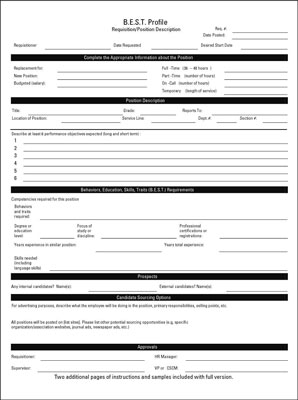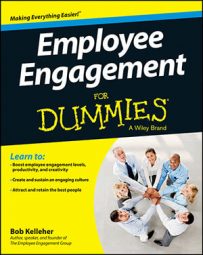The trick to hiring the best new employee with the right combination of Behaviors, Education, Skills, and Traits (BEST) is knowing what behaviors, education, skills, and traits will yield superior performance for the job you seek to fill, and developing a job description that takes these into account. This will involve some thinking on your part.
Many organizations kick off the hiring/selection process by filling out the dreaded new-hire requisition form. Generally, these forms are all about education and skills, with little focus on behaviors and traits. The focus of these static documents is a job description; they request information on experience, academics, industry, responsibilities, competencies, blah, blah, blah.
No pressure, but doing a really good job on this task is very important. Your efforts here will direct all subsequent activities involved with hiring a high-performance candidate who is ready to be engaged.
First, define six to eight performance objectives for the position. Here are some examples of performance objectives (these will vary based on the position and your needs):
Improve the organization of the department by creating and maintaining an accurate filing system for both hard-copy and electronic versions of material.
Successfully manage at least four projects to conclusion, within 10 percent of budget and 10 percent of deadline.
Lead the social media advertising campaign for the company's six divisions, working within the desired budget and timeline.
Open eight new branch locations within the next six months.
Hire two new field technicians within the next two months, and have them fully trained in all product lines within the first nine months of their hire date.
Evaluate and create a plan to improve the intranet site for ease of use, aesthetics, and navigation.
Build a succession plan for the firm's top 100 positions by the end of the calendar year.
With these performance objectives in hand, consider what behaviors, education, skills, and traits a candidate will need in order to meet your performance objectives. For example, if you've established a performance objective of leading the social media advertising campaign for the company's six divisions, working within the desired budget and timeline, the applicable behaviors, education, skills, and traits may include the following:
Behaviors: Shows initiative, is a self-starter, collaborates, exhibits autonomy, exhibits self-discipline
Education: Bachelor's degree in communication, master's degree in digital media preferred
Skills: Outstanding written and oral communication skills, knowledge of current social media and search optimization trends, expertise in mobile technology applications
Traits: Creative, tenacious, competitive, high achiever
This information will serve as the foundation for the position's job description.
Naturally, some behaviors, education, skills, and traits will be more important than others. For this reason, you may opt to weight them.
If you wind up with several behaviors, education credentials, skills, and traits in your list, consider dividing them into two categories: absolute and desirable. Behaviors, education credentials, skills, and traits in the “absolute” category must be present or the candidate is not eligible for the position. Desirable behaviors, educational credentials, skills, and traits are “nice to haves.”
In other words, they would add value to a candidate. For example, you might say that an associate's degree is required (as a “must have,” it's in the “absolute” category), and a bachelor's degree is preferred (it's a “nice to have,” in the “desirable” category).
You might even go so far as to weight behaviors, educational credentials, skills, and traits to aid in your decision making. For example, you might weight having a general bachelor's degree as a 5, a bachelor's degree in a subject directly related to the role as an 8, and a bachelor's degree in a related subject from a top-tier school in that discipline as a 10.
Not sure what behaviors, education credentials, skills, and traits will best serve a performance objective? Think about the employees you currently have who are excelling in a position like the one you seek to fill and pinpoint their BEST characteristics.
For example, if you're looking to hire a sales/account executive, take an inventory of your current high-performing sales/account executives and determine what behaviors, education credentials, skills, and traits they possess. This will give you an idea of the BEST requirements for that position.
You'll also want to devise a series of questions designed to suss out whether a candidate has the requisite behaviors, education credentials, skills, and traits.
This is a worksheet that might help you develop a job description that factors in the BEST model — called a “BEST profile.” Feel free to modify or copy it and use it in your own organization.


